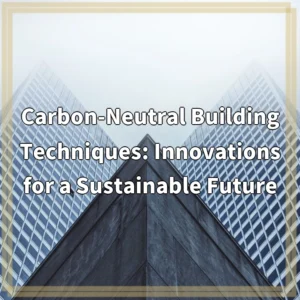
What is Exploring Eco-Friendly Architectural Materials and Techniques?
Exploring Eco-Friendly Architectural Materials and Techniques is a concept that revolves around designing and constructing buildings in a way that minimizes their negative impact on the environment. It involves an extensive examination of various sustainable design elements, including the materials used, construction techniques employed, and the overall impact on the ecosystem.
Real-World Problems Associated with Eco-Friendly Architectural Materials and Techniques
As we strive to create more sustainable and eco-friendly buildings, there are several real-world problems that need to be addressed. These challenges can include:
1. Limited availability of eco-friendly materials
One of the key challenges in adopting eco-friendly architectural materials and techniques is the limited availability of such materials in the market. While there has been a gradual increase in sustainable alternatives, they are often more expensive or have limited availability compared to traditional construction materials.
2. Lack of awareness and education
Many architects, builders, and homeowners still lack awareness and understanding of the benefits and practicality of eco-friendly architectural materials and techniques. Without proper education and awareness, it becomes challenging to implement sustainable design practices.
3. Resistance to change in the industry
The architectural and construction industry has long been entrenched in traditional practices. Implementing eco-friendly materials and techniques requires a shift in mindset and a willingness to embrace change. Resistance to change within the industry can pose a significant hurdle to widespread adoption of sustainable design practices.
4. Performance and durability concerns
A common concern with eco-friendly materials and techniques is their performance and durability over time. Some sustainable materials may have limitations in terms of strength, insulation capabilities, or resistance to natural elements. Overcoming these performance concerns while maintaining eco-friendly attributes is an ongoing area of research and development.
5. Balancing cost and sustainability
Balancing cost and sustainability is often a challenge in eco-friendly architectural projects. While sustainable materials and techniques have long-term benefits in terms of energy efficiency and reduced environmental impact, the upfront costs can be higher. Finding the right balance between cost and sustainability is a crucial consideration in ensuring the widespread adoption of eco-friendly design practices.

Potential Solutions to Real-World Problems of Eco-Friendly Architectural Materials and Techniques
Although there are challenges in implementing eco-friendly architectural materials and techniques, there are also various potential solutions that can help overcome these hurdles. Some of these solutions include:
1. Increasing availability and accessibility
To address the limited availability of eco-friendly materials, efforts can be made to increase production and distribution. This can involve supporting and promoting sustainable material suppliers and manufacturers, as well as encouraging research and development in creating new and improved eco-friendly alternatives.
2. Enhancing education and awareness
Creating educational initiatives and awareness campaigns can help bridge the knowledge gap surrounding eco-friendly architectural materials and techniques. Architects, builders, and homeowners can be informed about the advantages, cost-effectiveness, and long-term benefits of sustainable design practices, leading to increased adoption and demand.
3. Collaboration and industry partnerships
Collaboration between architects, builders, material suppliers, and other stakeholders is key to driving change within the industry. Establishing partnerships can foster knowledge exchange, research collaborations, and the development of innovative solutions that meet both sustainability goals and performance requirements.
4. Advancements in technology and research
Continued advancements in technology and research can address concerns around the durability and performance of eco-friendly materials. Investing in research and development can lead to the creation of new materials that are not only sustainable but also possess the necessary strength, insulation qualities, and resilience to withstand various environmental conditions.
5. Financial incentives and policy support
Offering financial incentives and policy support can encourage the adoption of eco-friendly architectural materials and techniques. This can include tax credits, grants, and subsidies for sustainable building projects, as well as the development of building codes and regulations that prioritize energy efficiency and environmental impact reduction.















